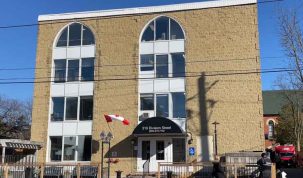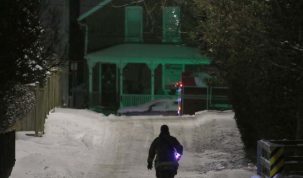By Cecilia Nasmith/Today’s Northumberland
Compared to other parts of Ontario, Haliburton Kawartha Pine Ridge District Health Unit Medical Officer of Health Dr. Natalie Bocking says this region is faring quite well.
The local incidence rate is 6.9 cases per 100,000 population, for example, compared to almost 100 per 100,000 seen in other health-unit jurisdictions.
The test positivity rate at this time is 0.7%, Dr. Bocking added, and there are currently no outbreaks.
“Since the beginning of this school year, 25 cases have been identified among the school-age population or staff and teachers, none of them related to spread within the schools,” she added.
“They were all acquired from exposure outside the school setting.”
At this time, she warned, vaccine coverage as it stands – with 86.5% of the population aged 23 and up having one shot and 83.7% of this population having two – is not high enough to prevent further community transmission or sporadic outbreaks. Of the 24 cases identified in the past two weeks, almost half – 41.7% – could not be traced to an identifiable source.
“That’s a general indication of community transmission,” Dr. Bocking stated.
And though the vast majority of those cases were in the 20-to-39 age group, fully one-quarter of those cases were aged 50 to 59.
“There were 27 hospital admissions. To me, that indicates COVID-19 can still continue to cause significant illness.”
Of 362 COVID cases reported since July 1, Dr. Bocking continued, 61.3% had no vaccinations. Some 18.3% were either partially vaccinated or considered not yet fully protected by vaccination.
One-fifth or 20% were fully vaccinated.
“This isn’t surprising,” she declared.
“It’s not a concerning trend. I think we know the vaccinations are not 100% effective. They are very protective, and quite effective at preventing severe illness, hospital admissions, ICU stays. They are good protection against symptomatic illness, but not 100% protection.
“They still are the best prevention tool we have, so we still encourage everyone that has not yet been vaccinated to seek out the COVID vaccine.”
Unfortunately, however, there has been a steady decline in people coming in for that first shot, from about 1,000 a week a few weeks back to about 200 to 300 a week nowadays.
“We know there are still 23,000 people across all of HKPR jurisdiction that could still get their first dose of COVID vaccine today.
“Many other regions in the province have been able to reach the 90% target of a least one dose if not two, which is what the goal is. I think we can certainly still achieve this across HKPR, but on a very slow trajectory.
“I would encourage anyone who has yet to be vaccinated against COVID-19 to at least discuss it with your health-care provider to ensure you have accurate information about the vaccine. And for family members and friends who know anyone not vaccinated, have a respectful conversation about the risks and benefits of the vaccine and point them to sources of information that are accurate.”
With the time for boosters and third doses approaching, and the impending okay for children aged five to 11 to be vaccinated, the health unit has once again set up five mass-immunization clinics.
In Northumberland, sites at the Cobourg Community Centre and the Keeler Centre in Colborne are now open on weekdays, though Dr. Bocking urged anyone hoping to access them to check hours on the health unit website as days and hours vary.
On weekends, clinics are set up at a number of high schools, open to members of the community as well as to staff and students.
While those seeking first and second shots can walk in, those hoping for a booster are asked to book through the provincial website to ensure the convenience of a spot specially set aside for them – though for those who cannot do so, there is the opportunity during the last hour of the day (3:30 to 4:30 p.m.) to take a chance and show up for a walk-in.
Pharmacies continue to offer the vaccine, Dr. Bocking added, and each of these locations will have their own processes, procedures and booking set-up.
For the moment, third shots and boosters are available to certain specific populations – those who have designated medical conditions, those born in 1951 or earlier, health-care workers and essential care givers, Indigenous communities and members of their households (on reserve of not) and those whose original vaccinations were AstraZeneca or Johnson & Johnson. In every case, she added, a window of 168 days is required between the date of their second shot and the date of their third.
Looking ahead to such time as Health Canada approves the Pfizer vaccine for five-to-11-year-olds (within weeks, Dr. Bocking expects), the National Advisory Committee on Immunization will issue their recommendations on the vaccination of that age group and the province will officially give direction on proceeding.
Issues around supply are not anticipated, she said. For one thing, these doses are smaller – they even come in different vials. Assurances on supply have also been received from both provincial and Federal governments.
Parents will have multiple ways to access the vaccine at that time – some primary-care clinics, the mass-immunization clinics, pharmacies.
“We do have approximately 11,000 kids five to 11 across all of Northumberland County, the City of Kawartha Lakes and Haliburton County,” Dr. Bocking estimated.
“And we are anticipating when the province gives the go-ahead, it will be everybody all at once. There won’t be a tiered system the way we saw with adults.”
The health unit – along with many agencies – is working on resources about vaccine risks and benefits for parents of five-to-11-year-olds, because they anticipate these parents will have lots of questions.
Then, once a solid start has been made on protecting this age group, Dr. Bocking expects the province will amend its direction on age groups, lowering them in stages so that this group can get its boosters.
In a province where COVID is surging in other areas, she said, “we know we are not an island. We know people travel in and out of HKPR jurisdiction. But there are tools we know work.”
These fall into two broad groups.
Vaccinations are the strongest tool available.
And the other tool is the basic health measures everyone knows by now. If you are sick, stay home. If you have symptoms consistent with COVID-19, get tested. If you are out in public, keep your distance and/or wear a mask – and wear it properly. And exercise caution in choosing what gatherings and events you attend.























